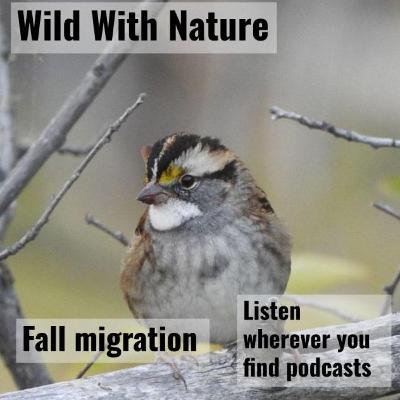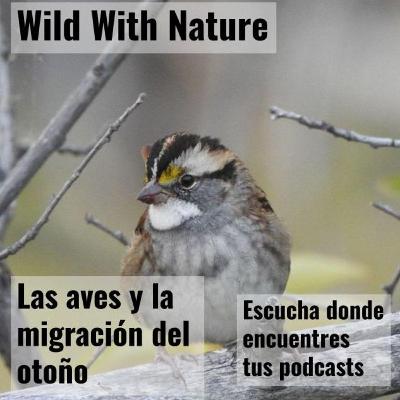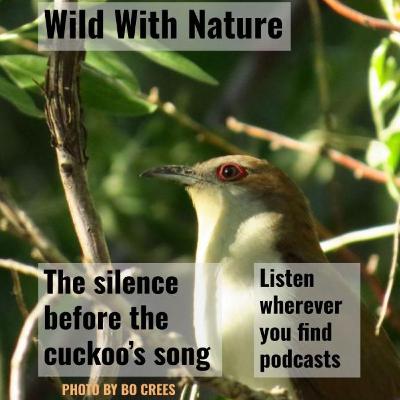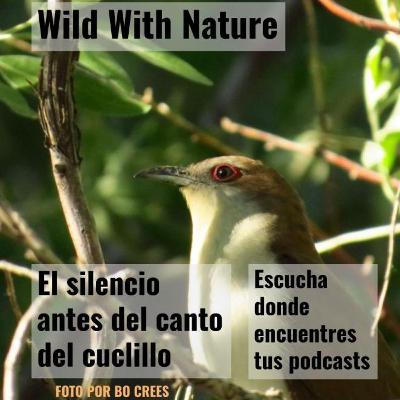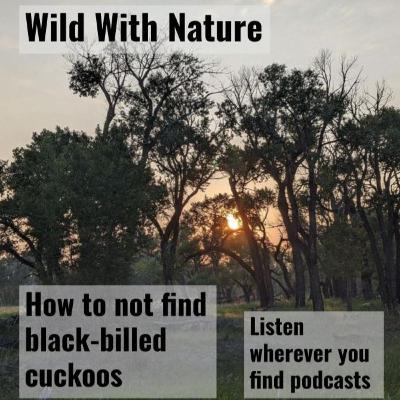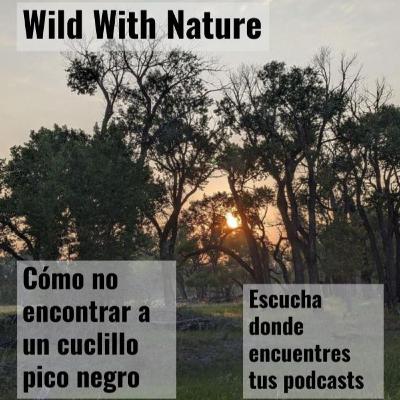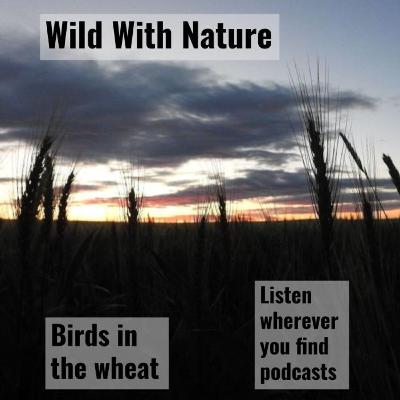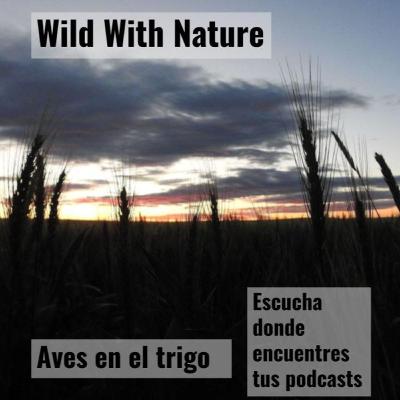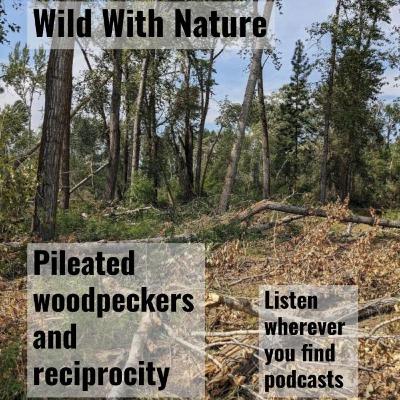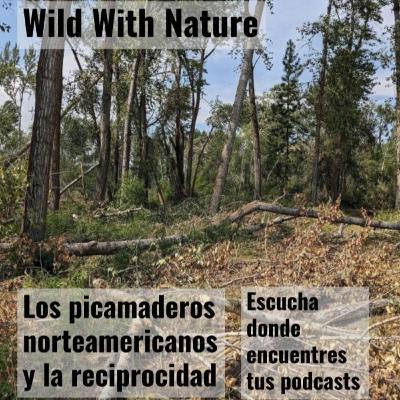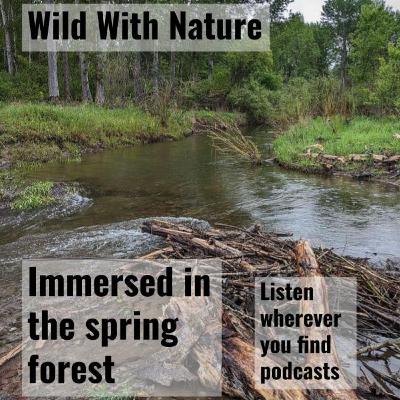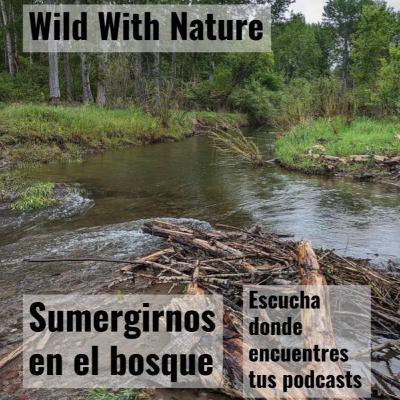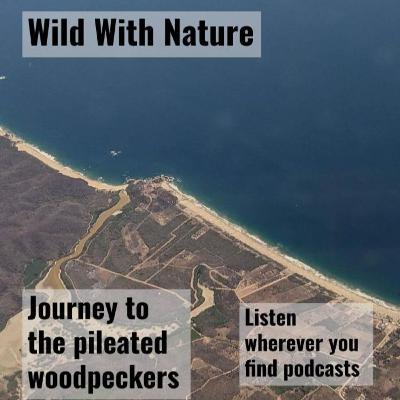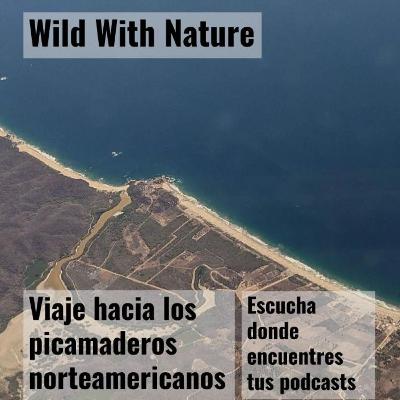Discover Wild With Nature
Wild With Nature

Wild With Nature
Author: Shane Sater
Subscribed: 25Played: 412Subscribe
Share
© Shane Sater
Description
Bilingual (English/español) stories of birds, plants, insects, and other creatures that celebrate wonder, connection, and meaning through nature. New podcast at the beginning of each month. Enjoy these stories—and if you like them, please share them!
Historias bilingües (inglés/español) de aves, plantas, insectos y otras criaturas que celebran el asombro, la conexión y el sentido de la vida por la naturaleza. Publico un nuevo podcast al comienzo de cada mes. Disfruta estas historias—y si te gustan, ¡por favor compártelas!
Historias bilingües (inglés/español) de aves, plantas, insectos y otras criaturas que celebran el asombro, la conexión y el sentido de la vida por la naturaleza. Publico un nuevo podcast al comienzo de cada mes. Disfruta estas historias—y si te gustan, ¡por favor compártelas!
127 Episodes
Reverse
This month’s story is about the wonder of fall migration. The southward movement of billions of birds across the North American continent is so vast that it’s hard to imagine, impossible to comprehend. But there are glimpses: the fall flocks, the birds of summer gone without a goodbye, the sips and cheeps of hundreds of migratory sparrows from the weeds.This story is really special to me—and extra special because it’s my last one before I go on hiatus for a while. I’ve shared some more details about that towards the end of the episode.As usual, this story is an immersive soundscape with lots of bird sounds that I recorded in the field: from Montana, sounds of common grackle (Quiscalus quiscula), cedar waxwing (Bombycilla cedrorum), white-crowned sparrow (Zonotrichia leucophrys), yellow-rumped warbler (Setophaga petechia), white-throated sparrow (Zonotrichia albicollis), mourning warbler (Geothlypis philadelphia), various sparrows in a flock, eastern screech-owl (Megascops asio), swamp sparrow (Melospiza georgiana), and purple finch (Haemorhous purpureus). And from Oaxaca, the sharp calls of a ruby-throated hummingbird (Archilochus colubris).Independent podcasting isn’t easy, which is one of the reasons I’m taking a break for a while. In the meanwhile, all of the ways that you support this show remain greatly appreciated! Spreading the word about the podcast is huge, and leaving a rating helps too. And of course, my Patreon supporters are what’s kept me going this long. If you’re a current supporter, don’t worry—I’m pausing your monthly charges until I start podcast production again. And if you’re not a supporter but would like to look into it, please check out https://www.patreon.com/wildwithnature. Podcasting can be lonely at times, but knowing you’re there with me makes it much less so.You can find the written, illustrated version of this story here: https://wildwithnature.com/2025/10/01/fall-migration/
Esta historia se trata del asombro de la migración otoñal de las aves. El movimiento de miles de millones de aves hacia el sur a lo largo del continente norteamericano es tan enorme que es difícil de imaginar, imposible de comprender. Sin embargo, hay algunos atisbos: las bandadas del otoño, las aves del verano ya ausentes sin decir adiós, las llamadas sip y chip de cientos de gorriones migratorios en la maleza. Esta historia es muy especial para mí—y aún más porque es mi última antes de tomar una pausa por un rato. He compartido unos detalles más sobre eso al final del episodio. Como siempre, esta historia te sumerge en los sonidos de las aves que grabé en el campo: desde Montana, los sonidos del zanate norteño (Quiscalus quiscula), chinito (Bombycilla cedrorum), gorrión corona blanca (Zonotrichia leucophrys), chipe rabadilla amarilla (Setophaga petechia), gorrión garganta blanca (Zonotrichia albicollis), chipe de pechera (Geothlypis philadelphia), una bandada de varios gorriones, tecolote del este (Megascops asio), gorrión pantanero (Melospiza georgiana) y pinzón colorado (Haemorhous purpureus). Y desde Oaxaca, México, las llamadas agudas de un colibrí garganta rubí (Archilochus colubris).Producir un podcast independiente no es fácil, y eso es una de las razones por las que quiero tomar una pausa. Mientras tanto, te sigo agradeciendo mucho por todas las maneras en las que apoyas este proyecto! Compartir mis podcasts es una gran ayuda, y dejarme un rating también me ayuda. Y desde luego, mis patrocinadores en Patreon son los que han sostenido mi trabajo hasta este momento. (Si eres uno de mis patrocinadores, no te preocupes—no se te va a cobrar tu apoyo mensual hasta que yo comience de nuevo con la producción del podcast.) Si aún no eres un patrocinador pero te interesa considerarlo, por favor chécalo en https://www.patreon.com/wildwithnature. Hacer un podcast a veces puede sentirse muy solo, pero saber que estás ahí conmigo ayuda mucho.Puedes encontrar la versión escrita con la historia aquí, con mis fotos del campo: https://wildwithnature.com/2025/10/01/aves-migracion-de-otono/
I hear it as soon as I step out of the car, that resonant, knocking cucucu that I’ve been listening for all across Montana this summer. Black-billed cuckoo! My hands are shaking and my heart is thumping. I slip one headphone on, aim the parabola, and press record. The cuckoo keeps singing.The black-billed cuckoo is a bird of many mysteries. In this podcast I delve into the biology and wonder of this bird, from the western edge of its breeding range in Montana, USA to the even more mysterious wintering distribution in Colombia and Ecuador. Many thanks to Anna Kurtin (University of Montana) and Dr. Camila Gómez (SELVA, selva.org.co) for their participation in this story, and to their research teams for all of their contributions to our understanding of cuckoos. Thanks to Harriet Marble for telling me about a possible black-billed cuckoo report near the Highwood Mountains, which finally allowed me to observe one! Finally, thanks to Tim Spahr for his permission to include his black-billed cuckoo song and flight call recordings in the podcast, and to Ian van Coller, Bo Crees, and Peter Dudley for letting me include their photos in the written version.Besides Tim Spahr’s black-billed cuckoo song and calls, this podcast also includes many of my own sound recordings from Montana: black-billed cuckoo (Coccyzus erythropthalmus), black-headed grosbeak (Pheucticus melanocephalus), great horned owl (Bubo virginianus), yellow-breasted chat (Icteria virens), orchard oriole (Icterus spurius), northern house wren (Troglodytes aedon), eastern warbling-vireo (Vireo gilvus), Baltimore oriole (Icterus galbula), western wood-pewee (Contopus sordidulus), common nighthawk (Chordeiles minor), American kestrel (Falco sparverius), and brown thrasher (Toxostoma rufum). Also an eastern screech-owl (Megascops asio) from Nebraska and a Middle American screech-owl (M. guatemalae) from Oaxaca, Mexico.As always, I depend on the support of my listeners to continue doing this work. Please share these podcasts, leave a rating, and, if you’re able, support me through Patreon: https://www.patreon.com/wildwithnature. Thank you!!!You can find the written, illustrated version of this story here: https://wildwithnature.com/2025/09/01/the-silence-before-the-cuckoos-song/
Lo escucho inmediatamente al bajar del carro, ese cucucú resonante que he estado buscando por todas partes de Montana este verano. ¡Un cuclillo pico negro! Mis manos están temblando y mi corazón está latiendo fuerte. Me pongo un solo audífono, apunto la parábola y empiezo a grabar. El cuclillo sigue cantando.El cuclillo pico negro (Coccyzus erythropthalmus) es un ave de muchos misterios. En este podcast profundizo en la biología y el asombro de esta especie, desde el margen occidental de su distribución reproductiva en Montana, EU hasta la distribución no reproductiva aún menos conocida en Colombia y Ecuador. Muchas gracias a Anna Kurtin (Universidad de Montana) y a la doctora Camila Gómez (SELVA, selva.org.co) por su participación en esta historia, y a sus equipos de investigación por todas sus contribuciones a nuestro conocimiento de esta especie. Agradezco a Harriet Marble por contarme de un posible reporte de un cuclillo pico negro cerca de las Montañas Highwood, que finalmente me permitió observar a uno. Gracias también a Tim Spahr por su permiso para incluir sus grabaciones del canto y la llamada de vuelo del cuclillo en el podcast, y a Ian van Coller, Bo Crees y Peter Dudley por dejarme incluir sus fotos en la versión escrita.Además del canto y la llamada de vuelo del cuclillo grabados por Tim Spahr, el podcast también incluye muchas de mis propias grabaciones desde Montana, EU: cuclillo pico negro (Coccyzus erythropthalmus), picogordo tigrillo (Pheucticus melanocephalus), búho cornudo (Bubo virginianus), chipe grande (Icteria virens), calandria castaña (Icterus spurius), saltapared común norteño (Troglodytes aedon), vireo gorjeador del este (Vireo gilvus), calandria de Baltimore (Icterus galbula), papamoscas del oeste (Contopus sordidulus), chotacabras zumbón (Chordeiles minor), cernícalo americano (Falco sparverius) y cuicachoche castaño (Toxostoma rufum). También un tecolote del este (Megascops asio) desde Nebraska, EU y un tecolote sapo (M. guatemalae) desde Oaxaca, México.Como siempre, dependo del apoyo de mis oyentes para seguir con este proyecto. Favor de compartir estos podcasts, dejarme un rating y (si puedes) hacerme una cooperación a través de Patreon: https://www.patreon.com/wildwithnature. Muchísimas gracias!!!Puedes encontrar la versión escrita con la historia aquí, con muchas fotos del campo: https://wildwithnature.com/2025/09/01/el-silencio-antes-del-canto-del-cuclillo/
It was the possibility—slim though it was—of black-billed cuckoos (Coccyzus erythropthalmus) that brought me to the Marias River. In 2021, while Anna Fasoli was floating the river, she heard and recorded a singing cuckoo here. This is a bird that I’ve lived my whole life without encountering, a bird which a long-ago generation of nineteenth-century naturalists would observe descending on orchards in flocks to feed on caterpillars. Hardly anyone sees flocks of black-billed cuckoos now. To see a cuckoo at all, at least in Montana, is a rare encounter that takes a lot of effort, a lot of luck, or both. But the decline of black-billed cuckoos, like almost every aspect of their biology, remains shrouded in unknowns. And so here I am, listening to rock wrens in a dark badlands gully, bound for the river and imagining cuckoos.This month’s story will immerse you in a world at the river’s edge that black-billed cuckoos inhabited—and do they still? The podcast includes many of my natural sound recordings: rock wren (Salpinctes obsoletus), northern house wren (Troglodytes aedon), great horned owl (Bubo virginianus), grasshopper sparrow (Ammodramus savannarum), eastern kingbird (Tyrannus tyrannus), gray catbird (Dumetella carolinensis), Swainson’s thrush (Catharus ustulatus), western wood-pewee (Contopus sordidulus), least flycatcher (Empidonax minimus), yellow-headed blackbird (Xanthocephalus xanthocephalus), red-naped sapsucker (Sphyrapicus nuchalis), and black-headed grosbeak (Pheucticus melanocephalus). As well as the alarm sound of a beaver (Castor canadensis). In other words, it’s a journey among a sea of sounds from the riparian zone! As always, I depend on the support of my listeners to continue doing this work. Please share these podcasts, leave a rating, and, if you’re able, support me through Patreon: https://www.patreon.com/wildwithnature. Thank you!!!You can find the written, illustrated version of this story here: https://wildwithnature.com/2025/08/01/how-to-not-find-black-billed-cuckoos/
Fue la posibilidad—aunque pequeña—de un cuclillo pico negro (Coccyzus erythropthalmus) que me trajo hasta el Río Marias. En 2021, mientras Anna Fasoli andaba en kayak por el río, escuchó y grabó un cuclillo pico negro cantando aquí. Esto es un ave que he pasado toda la vida sin encontrar, un ave que una antigua generación de naturalistas del siglo diecinueve observaba descendiendo en los huertos frutales en parvadas para alimentarse de orugas. Ya casi nadie ve una parvada de cuclillos pico negro. Ver a tan solo un cuclillo, en Montana por lo menos, ya es algo raro que requiere mucho esfuerzo, mucha suerte o las dos cosas. Pero el declive de los cuclillos pico negro, como casi todos los aspectos de su biología, permanece mal entendido. Y así es que estoy aquí, escuchando a saltaparedes de rocas en una quebrada oscura dentro de las badlands, rumbo al río e imaginando cuclillos.La historia de este mes te va a sumergir en un mundo ribereño donde los cuclillos pico negro estaban— ¿y todavía están? El podcast incluye mis grabaciones del saltapared de rocas (Salpinctes obsoletus), saltapared común norteño (Troglodytes aedon), búho cornudo (Bubo virginianus), gorrión chapulín (Ammodramus savannarum), tirano dorso negro (Tyrannus tyrannus), maullador gris (Dumetella carolinensis), zorzal de anteojos (Catharus ustulatus), papamoscas del oeste (Contopus sordidulus), papamoscas chico (Empidonax minimus), tordo cabeza amarilla (Xanthocephalus xanthocephalus), carpintero nuca roja (Sphyrapicus nuchalis) y picogordo tigrillo (Pheucticus melanocephalus). Además del sonido de alarma de un castor (Castor canadensis). O sea, ¡es un viaje a través de un montón de sonidos de la zona ribereña!Como siempre, dependo del apoyo de mis oyentes para seguir con este proyecto. Favor de compartir estos podcasts, dejarme un rating y (si puedes) hacerme una cooperación a través de Patreon: https://www.patreon.com/wildwithnature. Muchísimas gracias!!!Puedes encontrar la versión escrita con la historia aquí, con muchas fotos del campo: https://wildwithnature.com/2025/08/01/como-no-encontrar-a-un-cuclillo-pico-negro/
4:49 a.m. It’s time to start counting birds. This is my seventh year doing this Breeding Bird Survey (BBS) route, one of over 4000 routes across the United States and Canada that volunteers like me survey one morning each summer. For many North American breeding birds, the BBS is our best stab at tracking how their populations are changing from year to year. Montana birder Harriet Marble started this BBS route in 1979 and surveyed it annually for the next 37 years. Each June I think of her as I follow in her footsteps. Everything is ready now. My notebook is out, the frequent stops sign taped to the back window of my car. As the horned larks tinkle and the prairie tries to seep in at the edges of the wheat, I set my 3-minute timer. Go!This month’s story is about my BBS route among the wheatfields of Chouteau County, Montana: a story of industrial agriculture, prairie bird declines, and all of the life that continues to persist in the face of it all. Many thanks to Harriet Marble for sharing her experiences of many decades on this route.This podcast features the voices of a variety of prairie birds that I recorded: horned lark (Eremophila alpestris), thick-billed longspur (Rhynchophanes mccownii), red-winged blackbird (Agelaius phoeniceus), gray partridge (Perdix perdix), chestnut-collared longspur (Calcarius ornatus), lark bunting (Calamospiza melodia), Franklin’s gull (Leucophaeus pipixcan) and black-necked stilt (Himantopus mexicanus).As always, I depend on the support of my listeners to continue doing this work. Please share these podcasts, leave a rating, and, if you’re able, support me through Patreon: https://www.patreon.com/wildwithnature. Thank you!!!You can find the written, illustrated version of this story here: https://wildwithnature.com/2025/07/01/wheat-industrial-agriculture-declining-birds/
Ya son las 4:49 a.m. Es hora de contar aves. Es mi séptimo año de hacer esta ruta del Conteo de Aves en Reproducción, una de más de 4000 rutas a lo largo de Estados Unidos y Canadá que hacen voluntarios como yo una mañana cada verano. Para muchas especies de aves que se reproducen en Norteamérica, este Conteo es nuestra mejor herramienta para observar cambios en sus poblaciones año tras año. La pajarera montanense Harriet Marble empezó esta ruta del Conteo en 1979 y la hizo anualmente durante los siguientes 37 años. Cada junio pienso en ella mientras sigo sus pasos. Ya tengo todo listo. Tengo mi cuaderno en la mano, el letrero del Conteo está pegado al parte trasera de mi carro. Mientras las alondras cornudas tintinean y la pradera trata de entrar en los bordes del trigo, pongo un alarma para tres minutos. ¡Ya!Esta historia se trata de mi ruta del Conteo de Aves en Reproducción entre los campos de trigo del Condado de Chouteau, Montana, EU: una historia de la agricultura industrial, declives de las aves de la pradera y toda la vida que sigue persistiendo frente a todo. Muchas gracias a Harriet Marble por compartir sus experiencias de muchas décadas en esta ruta.Este podcast destaca las voces de varias aves de la pradera que grabé yo: alondra cornuda (Eremophila alpestris), escribano pico grueso (Rhynchophanes mccownii), tordo sargento (Agelaius phoeniceus), perdiz pardilla (Perdix perdix), escribano collar castaño (Calcarius ornatus), gorrión alas blancas (Calamospiza melanocorys), gaviota de Franklin (Leucophaeus pipixcan) y monjita americana (Himantopus mexicanus).Como siempre, dependo del apoyo de mis oyentes para seguir con este proyecto. Favor de compartir estos podcasts, dejarme un rating y (si puedes) hacerme una cooperación a través de Patreon: https://www.patreon.com/wildwithnature. Muchísimas gracias!!!Puedes encontrar la versión escrita con la historia aquí, con muchas fotos del campo: https://wildwithnature.com/2025/07/01/trigo-industrial-aves-en-declive/
This story is the third and final in a series about pileated woodpeckers—a series that touches the earth of Oaxaca, Mexico, that invites us to immerse ourselves in a cottonwood forest in Montana, USA, that expands to touch on global themes like reciprocity and our human relationship with nature. This episode includes a passage by the writer Osprey Oreille Lake about reciprocity and gift economies from her book The Story is In Our Bones: How Worldviews and Climate Justice Can Remake a World in Crisis. Thanks to Osprey for giving me permission to quote her words. As always, I’ve also included various natural sound recordings that I made, among them: western wood-pewee (Contopus sordidulus) songs, pileated woodpecker (Dryocopus pileatus) calls and drumming, songs of a Wilson’s warbler (Cardellina pusilla) and a yellow warbler (Setophaga petechia), the call of a Cassin’s kingbird (Tyrannus vociferans), the wind through the tall dogbane (Apocynum cannabinum), the song of a Middle American screech-owl (Megascops guatemalae), songs of boreal chorus frogs (Pseudacris maculata), and a singing western screech-owl (Megascops kennicottii). As always, I depend on the support of my listeners to continue doing this work. Please share these podcasts, leave a rating, and, if you’re able, support me through Patreon: https://www.patreon.com/wildwithnature. Thank you!!!You can find the written, illustrated version of this story here: https://wildwithnature.com/2025/06/01/pileated-woodpeckers-and-reciprocity/
Esta historia es la tercera y final en una serie sobre los picamaderos norteamericanos—una serie que toca las tierras de Oaxaca, México, que nos invita a sumergirnos en un bosque de álamos por Montana, EU y que se expande para abordar temas globales como la reciprocidad y nuestra relación humana con la naturaleza. Este episodio incluye un pasaje de la escritora Osprey Oreille Lake sobre la reciprocidad y las economías de regalo de su libro The Story is In Our Bones: How Worldviews and Climate Justice Can Remake a World in Crisis. Gracias a Osprey por darme permiso para citar el pasaje. Como siempre, también incluye varias grabaciones de los sonidos de la naturaleza que hice yo, entre ellas: los cantos de los papamoscas del oeste (Contopus sordidulus), las llamadas y el tamborileo de los picamaderos norteamericanos (Dryocopus pileatus), los cantos de un chipe corona negra (Cardellina pusilla) y un chipe amarillo (Setophaga petechia), la llamada de un tirano chibiú (Tyrannus vociferans), el viento por el cáñamo americano (Apocynum cannabinum), el canto de un tecolote sapo (Megascops guatemalae), los cantos de unas ranas de coro (Pseudacris maculata) y el canto de un tecolote del oeste (Megascops kennicottii). Como siempre, dependo del apoyo de mis oyentes para seguir con este proyecto. Favor de compartir estos podcasts, dejarme un rating y (si puedes) hacerme una cooperación a través de Patreon: https://www.patreon.com/wildwithnature. Muchísimas gracias!!!Puedes encontrar la versión escrita con la historia aquí, con muchas fotos del campo: https://wildwithnature.com/2025/06/01/picamaderos-norteamericanos-y-reciprocidad/
As spring arrives in full force across the temperate regions of the northern hemisphere, I invite you to take a few minutes to immerse yourself in the sounds and happenings of a spring black cottonwood (Populus balsamifera) forest along the Clark Fork River near Missoula, Montana, USA. This is part two in a three-part series following a pair of nesting pileated woodpeckers (Dryocopus pileatus). In this episode, I track them from the end of cavity excavation in late April through the nestling stage in mid-June.This story features wildlife photographers Lea Frye (https://leaf-images.com/) and Rachel Ritacco (https://www.ritaccophotography.com/), who accompanied me on one of my visits to the pileated woodpecker nest. As usual, the podcast includes an abundance of audio I recorded in the field, including various cuts of pileated woodpeckers as well as sounds of American robin (Turdus migratorius), tree swallow (Tachycineta bicolor), song sparrow (Melospiza melodia), red-naped sapsucker (Sphyrapicus nuchalis), northern waterthrush (Parkesia noveboracensis), northern house wren (Troglodytes aedon), wind in the cottonwoods, and May rain.As always, I depend on the support of my listeners to continue doing this work. Please share these podcasts, leave a rating, and, if you’re able, support me through Patreon: https://www.patreon.com/wildwithnature. Thank you!!!You can find the written, illustrated version of this story here: https://wildwithnature.com/2025/05/01/pileated-woodpecker-nest/
Mientras la primavera viene llegando con fuerza a través de las regiones templadas del hemisferio norte, te invito a pasar unos minutos sumergiéndote en los sonidos y acontecimientos de un bosque primaveral de álamo negro (Populus balsamifera) cerca del Río Clark Fork por Missoula, Montana, EU. Esto es la segunda parte en una serie de tres partes siguiendo la anidación de una pareja de picamaderos norteamericanos (Dryocopus pileatus). En este episodio, te cuento la historia desde completar la excavación del nido a finales de abril hasta alimentar a su pichón a mediados de junio.Esta historia destaca a las fotógrafas de la vida silvestre Lea Frye (https://leaf-images.com/) y Rachel Ritacco (https://www.ritaccophotography.com/), que me acompañaron en una de mis visitas al nido de los picamaderos norteamericanos. Como siempre, el podcast incluye una selección abundante de audio que grabé en el campo, incluso varias grabaciones de los picamaderos norteamericanos además de sonidos del mirlo primavera (Turdus migratorius), golondrina bicolor (Tachycineta bicolor), gorrión cantor (Melospiza melodia), carpintero nuca roja (Sphyrapicus nuchalis), chipe charquero (Parkesia noveboracensis), saltapared común norteño (Troglodytes aedon), el viento por los álamos y la lluvia de mayo. Como siempre, dependo del apoyo de mis oyentes para seguir con este proyecto. Favor de compartir estos podcasts, dejarme un rating y (si puedes) hacerme una cooperación a través de Patreon: https://www.patreon.com/wildwithnature. Muchísimas gracias!!!Puedes encontrar la versión escrita con la historia aquí, con muchas fotos del campo: https://wildwithnature.com/2025/05/01/anidacion-picamaderos-norteamericanos/
The hot March winds buffet the jet as we thunder skyward, shattering the quiet of the dry tropical forest below and spewing hot gases of ancient sea life. I crane my head and say a silent goodbye to the Huatulco landscape that has become a second home to me. We’ve already rocketed higher than the Cerro Huatulco; the dry course of the Arroyo Todos Santos slips by in an instant and then we’re banking towards the coast, a wide wide turn over the tierra natal of my partner and generations of her family. Goodbye for now, my loved ones, que Dios los cuide. This story is a journey through the personal and the geopolitical in this critical time: a journey that seeks, as always, to strengthen our connection with the earth. Through bittersweet goodbyes, a tense international border crossing, and an unstable political landscape, this is my personal story of finding a positive way forward. It’s a journey towards the pileated woodpeckers, marking the beginning of this uncertain spring by immersing us in a cottonwood gallery forest where the woodpeckers are excavating their nest. I hope that you find something meaningful in it as you listen, just as I did as I was producing it.As usual, I’ve included lots of natural sounds that I recorded: a song sparrow (Melospiza melodia) serenading the spring, the pileated woodpeckers (Dryocopus pileatus) calling and excavating, a northern flicker (Colaptes auratus), a red-naped sapsucker (Sphyrapicus nuchalis), a flock of tree swallows (Tachycineta bicolor). And the distinctly not-so-natural sound of a jet taking off.As always, I depend on the support of my listeners to continue doing this work. Please share these podcasts, leave a rating, and, if you’re able, support me through Patreon: https://www.patreon.com/wildwithnature. Thank you!!!You can find the written, illustrated version of this story here: https://wildwithnature.com/2025/04/01/journey-to-the-pileated-woodpeckers/
Los vientos calurosos de marzo golpean el avión mientras subimos hacia el cielo, rompiendo la tranquilidad de la selva baja caducifolia por abajo y emitiendo gases calientes de la combustión de organismos marinos ancianos. Mirando hacia afuera, le digo un adiós silente a la tierra huatulqueña que se ha vuelto un segundo hogar para mí. Ya hemos ascendido más arriba del Cerro Huatulco; el lecho seco del Arroyo Todos Santos pasa en un instante y entonces estamos girando hacia la costa, un giro amplio sobre la tierra natal de mi pareja y generaciones de su familia. Adiós por ahora, mis seres queridos, que Dios los cuide. Esta historia es un viaje por lo personal y lo geopolítico en este tiempo crítico: un viaje que busca, como siempre, fortalecer nuestra conexión con la tierra. A través de un adiós difícil, cruzar la frontera en un momento tenso y un paisaje político bastante inestable, ésta es mi historia personal de buscar un camino positivo hacia adelante. Es un viaje hacia los picamaderos norteamericanos, sumergiéndonos en un bosque de galería de álamos donde los picamaderos están excavando su nido para marcar el comienzo de esta primavera incierta. Espero que encuentres algo importante mientras la escuches, tanto como yo encontré algo importante en producirla.Como siempre, he incluido muchos sonidos naturales que grabé: un gorrión cantor (Melospiza melodia) celebrando la primavera, los picamaderos norteamericanos (Dryocopus pileatus) llamando y excavando su nido, un carpintero de pechera común (Colaptes auratus), un carpintero nuca roja (Sphyrapicus nuchalis), una parvada de golondrinas bicolores (Tachycineta bicolor). Y el sonido no tan natural de un avión durante el despegue. Como siempre, dependo del apoyo de mis oyentes para seguir con este proyecto. Favor de compartir estos podcasts, dejarme un rating y (si puedes) hacerme una cooperación a través de Patreon: https://www.patreon.com/wildwithnature. Muchísimas gracias!!!Puedes encontrar la versión escrita con la historia aquí, con mis fotos del campo: https://wildwithnature.com/2025/04/01/viaje-hacia-picamaderos-norteamericanos/
It’s an afternoon in late April along the Clark Fork River near Missoula, Montana, USA. The song of the tall dogbane (Apocynum cannabinum) isn’t obvious, like the red-winged blackbirds (Agelaius phoeniceus) that are singing in the aspen grove on the other side of the river, or the European starlings (Sturnus vulgaris) that are nesting in the cavities of the cottonwoods. But the dogbane has a song, too, a song it sings with the wind. I can hear it this afternoon as last year’s dead stalks whisper and rustle in the breeze…This month’s story is all about tall dogbane, what makes this plant special to me, and (more broadly) how plants can help us. In this podcast, we follow a dogbane patch along Missoula, Montana’s Clark Fork River from spring into summer. As usual, we hear a variety of natural sounds that I recorded for the story, including wind, rain, and insects in the dogbane patch, plus red-winged blackbirds, European starlings, yellow warblers (Setophaga petechia), Wilson’s warblers (Cardellina pusilla), and western wood-pewees (Contopus sordidulus). In this episode, I make mention of a video by Sarah Corrigan of Roots School about gathering dogbane fibers. You can find that video here: https://www.youtube.com/watch?v=e5vPyRWGvDs.As always, I depend on the support of my listeners to continue doing this work. Please share these podcasts, leave a rating, and, if you’re able, support me through Patreon: https://www.patreon.com/wildwithnature. Thank you!!!You can find the written, illustrated version of this story here: https://wildwithnature.com/2025/03/01/tall-dogbane-fibers
Es una tarde a finales de abril cerca del Río Clark Fork unos kilómetros afuera de Missoula, Montana, EU. El canto del cáñamo americano (Apocynum cannabinum) no es nada obvio, a diferencia de los tordos sargentos (Agelaius phoeniceus) que están cantando desde los álamos temblones al otro lado del río. No llama la atención como los gritos de los estorninos pintos (Sturnus vulgaris) que están anidando en las cavidades de los álamos negros. Pero el cáñamo americano tiene un canto también, un estribillo que toca con el viento…El podcast de este mes se trata del cáñamo americano, por qué esta planta es tan especial para mí y (más ampliamente) cómo las plantas nos pueden ayudar. En este episodio, seguimos un parche de cáñamo americano cerca del Río Clark Fork por Missoula, Montana, EU desde la primavera hasta el verano. Como siempre, escuchamos una variedad de sonidos naturales que grabé para la historia, incluso el viento, la lluvia y los insectos en el cáñamo americano, además de unos tordos sargentos, estorninos pintos, chipes amarillos (Setophaga petechia), chipes corona negra (Cardellina pusilla) y papamoscas del oeste (Contopus sordidulus). En este episodio, menciono un video que hizo Sarah Corrigan de Roots School sobre el proceso de recolectar las fibras del cáñamo americano (desafortunadamente, el video sólo está disponible en inglés). Puedes encontrarlo aquí: https://www.youtube.com/watch?v=e5vPyRWGvDs.Como siempre, dependo del apoyo de mis oyentes para seguir con este proyecto. Favor de compartir estos podcasts, dejarme un rating y (si puedes) hacerme una cooperación a través de Patreon: https://www.patreon.com/wildwithnature. Muchísimas gracias!!!Puedes encontrar la versión escrita con la historia aquí, con mis fotos del campo: https://wildwithnature.com/2025/03/01/canamo-americano-apocynum-cannabinum/
What do moths have to do with owls? Just ask Mat Seidensticker. After nearly a decade spent studying owls across Montana and Alaska, Seidensticker focused his research on the flammulated owl, one of Montana’s smallest and most cryptic species. Soon, it became impossible for him to ignore the moths—insects that this owl hunts extensively during the summer.
This story is about moths in Montana, but it’s also about moths in ecosystems anywhere: a celebration of their importance and diversity, an invitation to learn.
As usual, it includes lots of ambient sound recordings that I made, all of these ones in Montana: flammulated owl, common poorwill (Phalaenoptilus nuttallii), common nighthawk (Chordeiles minor), tree crickets (Oecanthus sp.), aspen (Populus tremuloides) rustling in the wind, Swainson’s thrush (Catharus ustulatus), white-breasted nuthatch (Sitta carolinensis), Cassin’s finch (Haemorhous cassinii), and black-capped chickadee (Poecile atricapillus).
I depend on the support of my listeners to continue doing this work. Please share these podcasts, leave a rating, and, if you’re able, support me through Patreon: https://www.patreon.com/wildwithnature. Thank you!!!
You can find the written, illustrated version of this story here: https://wildwithnature.com/2025/02/01/why-moths-matter/To learn more about the Montana Moth Project, go to https://www.montanamothproject.org/.
¿Qué tienen las polillas que ver con los búhos? Pregúntale a Mat Seidensticker. Después de pasar casi una década estudiando búhos a través de Montana y Alaska, EU, Seidensticker enfocó sus investigaciones en una de las especies de búhos más crípticas y pequeñas que existe en Montana, el tecolote ojos oscuros (Psiloscops flammeolus). Pronto resultó imposible ignorar las polillas—unos insectos que este tecolote caza extensamente durante el verano.
Esta historia tiene que ver con las polillas de Montana, Estados Unidos, pero también se trata de las polillas en todos los ecosistemas de nuestro planeta: una celebración de su importancia y diversidad, una invitación a aprender.
Como siempre, incluye muchas grabaciones que hice de los sonidos de la naturaleza, esta vez todas en Montana: tecolote ojos oscuros, tapacaminos pandeagua (Phalaenoptilus nuttallii), chotacabras zumbón (Chordeiles minor), grillos de árbol (Oecanthus sp.), el sonido del álamo temblón (Populus tremuloides) en el viento, zorzal de anteojos (Catharus ustulatus), bajopalos pecho blanco (Sitta carolinensis), pinzón serrano (Haemorhous cassinii) y carbonero cabecinegro (Poecile atricapillus).
Dependo del apoyo de mis oyentes para seguir con este proyecto. Favor de compartir estos podcasts, darme un rating y (si puedes) hacer una cooperación a través de Patreon: https://www.patreon.com/wildwithnature. ¡Muchas gracias!
Aquí puedes ver la versión escrita de esta historia, con mis fotos: https://wildwithnature.com/2025/02/01/por-que-importan-las-polillas/Para aprender más sobre el Montana Moth Project, ve a https://www.montanamothproject.org/.
A simple whistle, ascending at the end, easy to imitate. It's the hour when the light departs, converting the trees into silhouettes, and the evening blue leaves the slopes of the Cerro Islá. The months of study crystallize in an instant and I'm almost running, the whistle calling me onwards, passing the milpa and the nopales, the starfruit and the cempasúchil, the beloved garden of grandfather Teo, passing the mangos, entering the jungle. The crickets are the voice of the approaching night, this whistle the mystery of the twilight.
---------
This is a story of the birds of the evening, of sustainable agriculture and biodiversity. From the bird life at the edge of a milpa—a traditional Mexican system of growing food in biologically diverse, small-scale plots—to the massive wheat fields of Montana and memories of an orchard from my childhood, this story invites us to consider how our food systems can support or harm the ecosystems we love.
Most of the ambient sounds in this story are ones I recorded in Oaxaca, Mexico in December 2024: crickets in the night, a thicket tinamou (Crypturellus cinnamomeus), Middle American screech-owl (Megascops guatemalae), collared forest-falcon (Micrastur semitorquatus), mottled owl (Strix virgata), and common pauraque (Nyctidromus albicollis). From Montana, USA, I share a recording I made in April 2024 of a pileated woodpecker (Dryocopus pileatus).
If you’d like to delve more into sustainable agriculture and biodiversity, I’ve shared several links with the written form of the story. In particular, I recommend Lorna Milne’s poignant and deeply personal essay “Losing Ty” (https://www.lornamilne.com/losing-ty), and Luke Hingtgen’s review of the inspiring book The Third Plate (https://edgeeffects.net/third-plate/).
I depend on the support of my listeners to continue doing this work. Please share these podcasts, leave a rating, and, if you’re able, support me through Patreon: https://www.patreon.com/wildwithnature. Thank you!!!
You can find the written, illustrated version of this story here: https://wildwithnature.com/2025/01/01/mystery-of-the-twilight/
Un silbido simple, ascendiendo al final, fácil de imitar. Es la hora cuando la luz se va, convirtiendo los árboles en siluetas, y el azul se va desapareciendo del Cerro Islá. Los meses de estudiar cristalizan en este instante y voy casi corriendo, el silbido llamándome adelante, pasando la milpa y los nopales, la carambola y el cempasúchil, el campo querido del abuelo Teo, pasando los mangos, entrando en la selva. Los grillos son la voz de la noche inminente, este silbido el misterio del crepúsculo.
---------
Ésta es una historia de las aves del anochecer, de la agricultura sustentable y la biodiversidad. Desde las aves al borde de una milpa—un sistema tradicional mexicano de producir comida en terrenos pequeños que hospedan mucha biodiversidad—hasta los campos masivos de trigo en Montana, EU y unos recuerdos de una huerta de frutos de mi juventud, ésta es una historia que nos invita a considerar cómo nuestros sistemas alimenticios pueden mantener o destrozar los ecosistemas que queremos.
La mayoría de los sonidos ambientales en esta historia son las que grabé en Oaxaca, México en diciembre de 2024: grillos en la noche, un tinamú canelo (Crypturellus cinnamomeus), unos tecolotes sapo (Megascops guatemalae), un halcón selvático de collar (Micrastur semitorquatus), un búho café (Strix virgata) y un chotacabras pauraque (Nyctidromus albicollis). También comparto una grabación de Montana, EU que hice en abril de 2024 de un picamaderos norteamericano (Dryocopus pileatus).
Dependo del apoyo de mis oyentes para seguir con este proyecto. Favor de compartir estos podcasts, darme un rating y (si puedes) hacer una cooperación a través de Patreon: https://www.patreon.com/wildwithnature. ¡Muchas gracias!
Aquí puedes ver la versión escrita de esta historia, con mis fotos: https://wildwithnature.com/2025/01/01/el-misterio-del-crepusculo/


